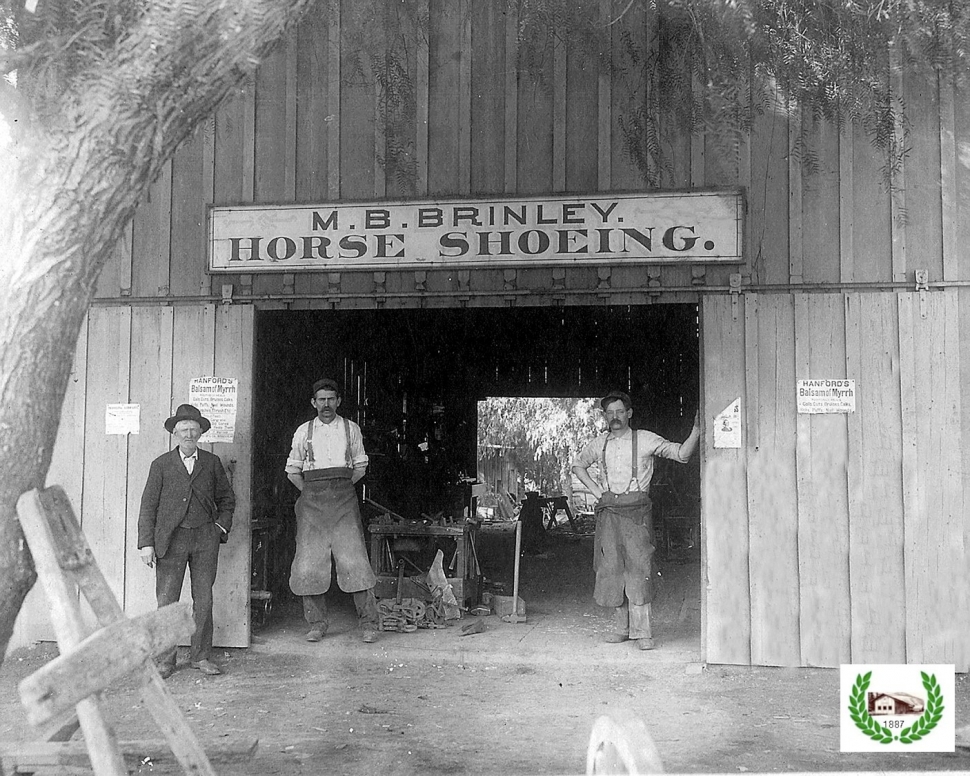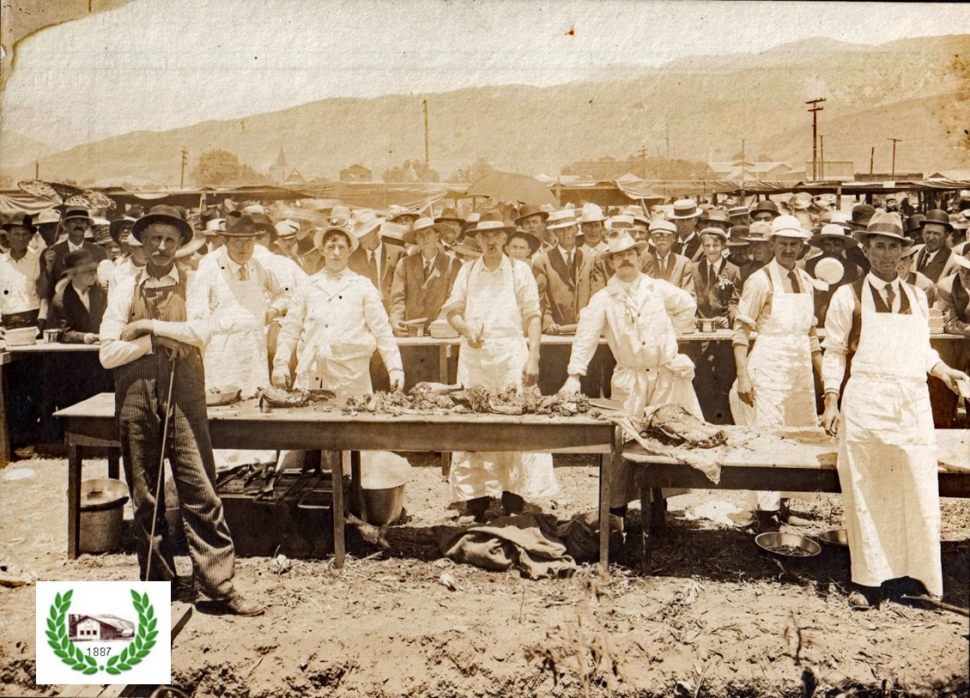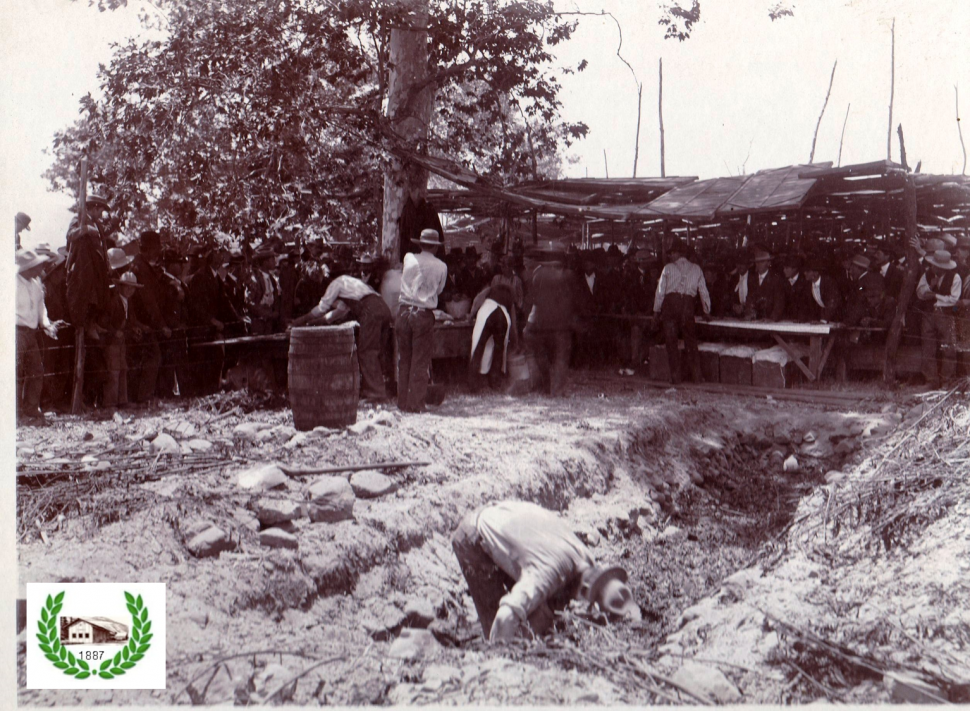
Pictured above is Brinley’s Blacksmith shop where, in 1907, several men took two 150-pound anvils and placed one upside down, filled the cavity with black powder, put the second one on top of the first and set it off by touching the powder with a red hot 15-foot iron rod. It woke the entire town to start the celebration of 4th of July. Photo courtesy Fillmore Historical Museum.

Above is Fillmore’s July 4 barbecue back in 1900. Inset, removing meat from BBQ pit. Photos courtesy Fillmore Historical Museum. More photos online at www.FillmoreGazette.com.

Courtesy Fillmore Historical Museum
It started with a bang which woke nearly everyone in Fillmore! Several very strong men had taken two 150 pound anvils from Brinley’s blacksmith shop, placed one upside down, filled the cavity with black powder, put the second one right side up on top of the first and set it off by touching the power with a red hot 15 foot iron rod. It was 5 a.m. July 4th in 1907.
Thirty five years earlier, in 1872, the festivities were much more sedate. A vote of the legislature in Sacramento on March 22, 1872, had approved the separation of Ventura from Santa Barbara County effective on January 1, 1873. So the 3500 county residents not only were celebrating the 4th but also the formation of the new Ventura County.
According to the “Ventura Signal” of July 19, 1872, the festivities were held at the “Hercynian” grove in “Spraguesville”. The location was most probably on the property (Now called Kenney Grove) owned by F .A. Sprague who would soon be elected a justice of the peace in the new county. A trio of ladies, Mrs. Guiberson, Mrs. Marple and Mrs. Haskins sang the Star Spangled Banner. Sprague read the Declaration of Independence and everyone present sang “America”. There were more patriotic speeches and songs followed by dinner prepared by the Sespe Ladies.
Eight years later, 1882, the 104th anniversary of American Independence would be celebrated in the “Hercynian” Oak grove then known as “Kenny’s” Grove. That year the celebration was on the 3rd of July as the 4th fell on a Sunday. Once again the festivities began with the singing of The “Star Spangled Banner” by the Sespe Glee Club. The Scienega choir followed with “Independence Day” sung in a very patriotic manner. Orations were made by the Honorable J.D. Hines. “Darius Green and his Flying Machine” was read by Miss Mattie E. Bain. (Look for the poem online.)
The eight years from 1872 to 1880 had seen an increase in the local population and the construction of school houses at Willow Grove south of the river and Sespe on the north, as well as increases in the population of Scienega and Sespe. The crowd enjoyed a barbecue of beef, pork, mutton, goat and venison. The deer had been killed the day before by Mrs. Ari Hopper. The bountiful dinner was followed by a baseball game between St. Julians and the Electric Lights. After two innings the crowd moved to the dance floor where the young people enjoyed some dancing and Ari Hopper gave a patriotic speech. In the evening all moved to the Sespe Schoolhouse where the “young people tripped the light fantastic” til midnight. On the night of the 4th everyone enjoyed fireworks at Santa Paula.
The arrival of the railroad in late 1887 allowed 4h of July celebration participants a faster trip to “Kenney” Grove. They did, however, have to walk from the Sespe or Brownstone stations to the grove. According to Edith Jarrett every livery stable owner probably met the train with a 16 passenger “tallyho” to ferry party goers to the event. But train passengers had to make the 4:30 train for home so most probably came in their own buggies.
The McNabs sycamore tree on the corner of First St and Saratoga was the location for the 1906 4th of July celebration. There were speeches and a band concert on a platform made of apricot pitting trays and apricot boxes. Blanche Guiberson sang the “Star Spangled Banner” accompanied by the Harmonson and Rood orchestra.
The 4th of July is today celebrated with safe and sane fireworks purchased at one of the 20 fireworks stands located in Fillmore and manned by members and friends of local nonprofit groups. This year the city will provide a fireworks show on the evening of the 3rd. But I’m sure community members will provide their own spectacular show on the 4th.
The manner and events of the day may have changed over time but the sentiment as we honor our flag and country is the same as it has been since horse and buggy days. So have a wonderful day, eat some barbeque and enjoy the show.



